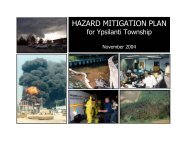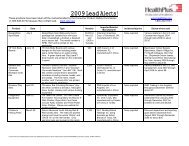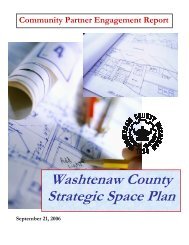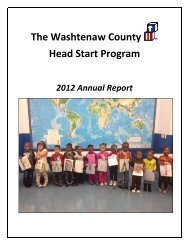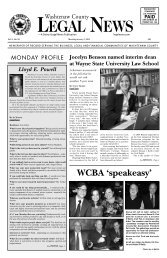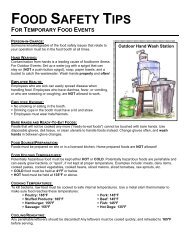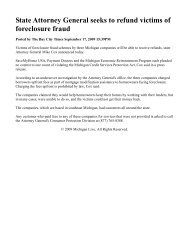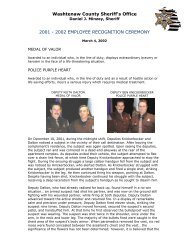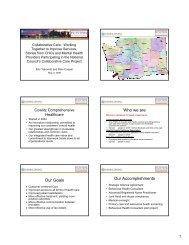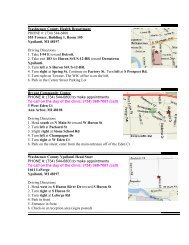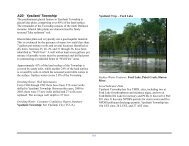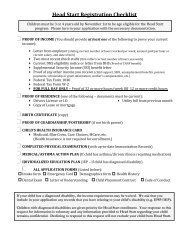Water Protection Activities in Washtenaw County
Water Protection Activities in Washtenaw County
Water Protection Activities in Washtenaw County
You also want an ePaper? Increase the reach of your titles
YUMPU automatically turns print PDFs into web optimized ePapers that Google loves.
Public Beaches Tested <strong>in</strong> <strong>Washtenaw</strong> <strong>County</strong>:<br />
● Bru<strong>in</strong> Lake Beach, Lyndon Township<br />
● Half Moon Lake Beach, Dexter Township<br />
● Independence Lake Beach, Webster Township<br />
● Silver Lake Beach, Dexter Township<br />
● Sugarloaf Lake Beach, Lyndon Township<br />
In addition to public beaches, many other rivers and streams<br />
runn<strong>in</strong>g through the <strong>County</strong> are sampled by local<br />
environmental organizations <strong>in</strong> order to determ<strong>in</strong>e current<br />
water quality and to recognize trends over time. Environmental<br />
surveys are conducted to evaluate possible pollution sources,<br />
safety hazards, depth drop-offs, currents, and hazardous<br />
objects.<br />
Activity #19 Natural Resource Environmental <strong>Protection</strong> Act<br />
(NREPA)<br />
The State of Michigan’s primary rules for protect<strong>in</strong>g and<br />
preserv<strong>in</strong>g water quality are outl<strong>in</strong>ed <strong>in</strong> the NREPA. The<br />
NREPA conta<strong>in</strong>s guidel<strong>in</strong>es for <strong>in</strong>land lake and stream<br />
preservation, wetland protection, construction erosion and<br />
sedimentation control, natural area preservation, etc.<br />
Activity #20 Illicit Discharge Elim<strong>in</strong>ation<br />
The <strong>Washtenaw</strong> <strong>County</strong> Dra<strong>in</strong> Commissioner, as part of the<br />
Phase II Storm <strong>Water</strong> Permit, conducts <strong>in</strong>spections of all<br />
<strong>County</strong> Dra<strong>in</strong>s and identifies possible discharges from sources<br />
that should be connected to sanitary sewer, as well as other<br />
illegal sources. In 2005, over 150 dra<strong>in</strong>s were <strong>in</strong>spected and 17<br />
illicit connections were identified and corrected.<br />
43<br />
Activity #21 Home Toxics Reduction Program<br />
The <strong>Washtenaw</strong> <strong>County</strong> Home Toxics Reduction Program<br />
provides residents with a disposal option for flammable,<br />
poisonous, toxic and corrosive materials. The program<br />
addresses the environmental and public health effects result<strong>in</strong>g<br />
from improper handl<strong>in</strong>g and disposal of home toxics, and is<br />
committed to reduc<strong>in</strong>g the use of home toxics and keep<strong>in</strong>g<br />
citizens <strong>in</strong>formed about the choices and responsibilities<br />
associated with purchas<strong>in</strong>g, handl<strong>in</strong>g and dispos<strong>in</strong>g of toxic<br />
substances.<br />
Activity #22 Waste Knot Program<br />
The <strong>Washtenaw</strong> <strong>County</strong> Waste Knot program aims to develop<br />
relationships with<strong>in</strong> the <strong>Washtenaw</strong> <strong>County</strong> bus<strong>in</strong>ess<br />
community to support waste reduction and recycl<strong>in</strong>g activities.<br />
The program provides community-wide recognition and<br />
organization-based technical assistance along with value-added<br />
education to organizations that exhibit leadership <strong>in</strong> waste<br />
reduction and recycl<strong>in</strong>g.<br />
Activity #23 <strong>Water</strong> Quality Stewardship Program<br />
<strong>Water</strong> Quality Stewardship Programs <strong>in</strong>clud<strong>in</strong>g Community<br />
Partners for Clean Streams, Homeowners Programs, and the<br />
new Riversafe Home Program (implemented <strong>in</strong> March/April<br />
2007), are all designed to help bus<strong>in</strong>ess, residential and other<br />
land owners to evaluate how their activities affect surface<br />
water quality, and to develop strategic action plans designed to<br />
reduce nonpo<strong>in</strong>t source pollution. These programs provide both<br />
technical assistance and community recognition.



